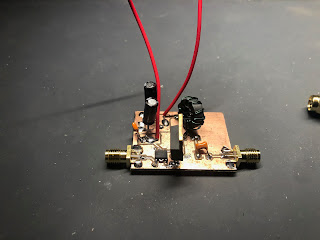I had a great time at the Minnesota Amateur Radio Technical Society meeting this past Saturday. Great conversation, and free stuff to boot! A beloved member had recently become a silent key (at almost 100), and his family had sent a bunch of his workbench stuff in to go to a good home.
Most interestingly, there was a 10W amp!
This is a QRP Labs 10W linear amplifier. Which I know about because I've built one, but never got it quite working. (I can't find my notes about the issues I was having). So this is exciting.
First of all, Mert did a way better job of boxing things up than I ever have.
On the inside, I found that there was a low pass filter on the output. Measuring with the vna, it looks like it is for 7MHz. Also, the transmitter powers the bias when the /tx pin is low. He has a phono jack for this, and made a little shorted plug to keep it on. Nice!
I hooked it up to a dummy load and powered it on with no input, and it looks like the bias is already set correctly.
Unfortunately, when I applied signal, nothing came out the other side.
Poking around, the bias at the irf510s looks right, but there was no signal.
The input BS170s have power and signal, but no output. So, those look blown. It got late tonight, so I'll have to wait to swap them out for another day.











